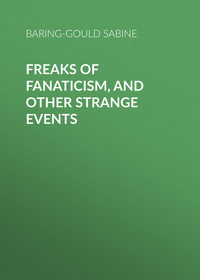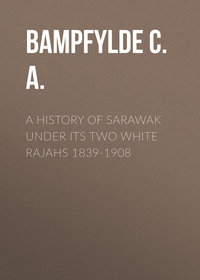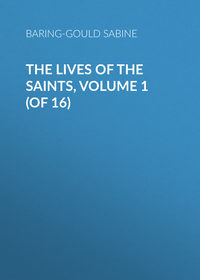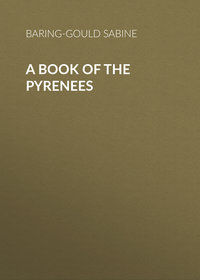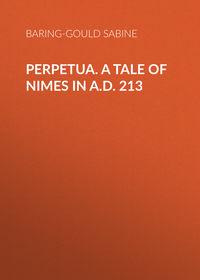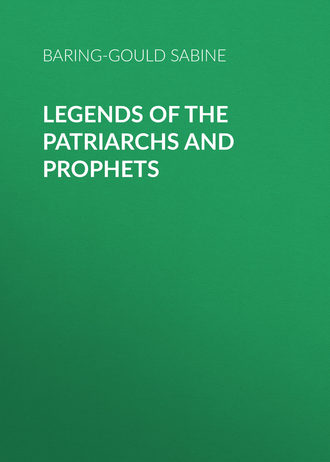 полная версия
полная версияLegends of the Patriarchs and Prophets
454
Yaschar, pp. 1241-53. The history of Zepho is quite a romance, too long for insertion here.
455
Yaschar, pp. 1248, 1249; 1253, 1254.
456
Ibid., p. 1255.
457
Midrash, fol. 51; Yaschar, p. 1157.
458
Midrash, Jalkut, fol. 52; Yaschar, pp. 1257-9.
459
The curious passages, Isaiah vii. 15, 22, may allude to this tradition.
460
Moses’ life was shortened because he brought water out of the rock contrary to God’s command (Numb xxvii. 14), striking the rock instead of speaking to it.
461
Beer, pp. 112-6.
462
Some authorities say that Jochebed, when thrust away, married Eliphazan, the son of Parnach (Numb. xxxiv. 25), and bare him two sons, Eldad and Medad (Numb. xi. 15); but others, with more probability, assert that she married Eliphazan after the death of Amram. (Yaschar, p. 1259.)
463
Yaschar, p. 1260.
464
Targum of Palestine, i. p. 446.
465
Rabboth, fol. 118 a.
466
Exod. xv. 1.
467
The Arabic name for her is Asia; Yaschar, p. 1261.
468
Targum of Palestine, i. p. 446; Yaschar, p. 1261.
469
Midrash, fol. 51.
470
Midrash, fol. 51; Yaschar, p. 1262.
471
Midrash, fol. 52; Yaschar, p. 1263.
472
According to another version, it was Jethro who advised that the child should be proved with the basins of rubies and coals (Rabboth, fol. 118 b; Yaschar, pp. 1263, 1264).
473
Exod. iv. 10.
474
Beer, pp. 26-42. Abulfaraj says that Jannes and Jambres were the tutors of Moses in his youth (Hist. Dynast., p. 17).
475
Yaschar, p. 1265.
476
Yaschar, p. 1265.
477
Ibid., p. 1263.
478
Parascha of R. Solomon Jaschi, on Exod. ii. 12; also Targums of Palestine and Jerusalem, i. p. 447; Yaschar, pp. 1265, 1266.
479
Pirke R. Eliezer, c. 40; Rabboth, fol. 119 a; Yaschar, p. 1266.
480
This illustrates the passage 2 Kings ix. 13.
481
Midrash, fol. 52; Yaschar, pp. 1265-1274.
482
These were two of his seven names.
483
It may be noticed in this as in several other instances, such as those of Rebekah and Rachel, the Rabbis have invented stories to explain the circumstance of the damsels watering the flock, which they supposed derogated from their dignity. This indicates the late date of these traditions, when the old pastoral simplicity was lost.
484
Pirke R. Eliezer, c. 40; Yaschar, p. 1274.
485
The Targum of Palestine, “ten years;” i. p. 448.
486
Beer, pp. 42-02; Pirke R. Eliezer. The Targum of Palestine says the rod was in the chamber of Jethro, not in the garden; i. p. 448. Yaschar, pp. 1277, 1278.
487
Rabbot., fol. 120 a. It is possible that our Blessed Lord’s parable of the Good Shepherd may contain an allusion to this popular and beautiful tradition.
488
Gen. iii. 4. It was the angel Zagnugael who appeared and spoke to him from the bush. (Targum of Palestine, i. p. 449; Abulfeda, p. 31.)
489
Exod. iv. 14.
490
Tabari, i. c. lxxiii. p. 24.
491
Midrash, fol. 54.
492
Targum of Palestine, i. p. 460.
493
Yaschar, p. 1280.
494
Tabari, p. 326.
495
Some say that Pharaoh entreated Moses to spare him for the sake of Asia (Bithia), and that at the mention of his name Moses was softened (Weil, p. 159)
496
In Arabic, Risam and Rijam; and Shabun and Gabun, in Persian.
497
Midrash, fol. 56. The Targums say that the enchanters turned the water of Goshen into blood, so that there was no water to the Israelites as to the Egyptians; i. p. 462.
498
Midrash, fol. 55.
499
Targum of Palestine, i. p. 463.
500
Venomous insects (Kalma), gnats (Kinnim). See Wisdom xvi. 1, 3.
501
Targums, i. 464.
502
Targums, i. p. 467.
503
Ibid., i. p. 471.
504
Yaschar, p. 1283.
505
Tabari, i. p. 338.
506
Weil, p. 165.
507
Talmud, Sota, fol. 13.
508
Targum of Palestine, i. p. 1478.
509
Targums, i. p. 475.
510
Ibid., i. p. 485.
511
Targum of Jerusalem, i. 488; Yaschar, p. 1287.
512
Exod. xiv. 13, 14.
513
Koran, Sura xxvi. v. 63.
514
Weil, p. 168; see also Midrash, fol. 176.
515
Exod. xv. 21.
516
Tabari, p. 350.
517
Tabari, i. p. 355.
518
Both the Rabbis and the Mussulmans lay the blame, not on Aaron, but on another. The Rabbis say it was Micah who made the calf; the Mussulmans call him Samiri. (Weil, p. 170.)
519
Targum of Palestine, i. p. 552.
520
Tabari, i. p. 362.
521
Targum of Palestine, ii. p. 685.
522
Pirke R. Eliezer, c. 45.
523
Weil, pp. 172, 173.
524
Koran, Sura vii. v. 139.
525
Tabari, i. p. 364.
526
Ibid., i. c. lxxv.
527
Targum of Palestine, i. p. 561.
528
Jalkut Rubeni, fol. 117, col. 1.
529
Jalkut Rubeni, fol. 107, cols. 2, 3.
530
Jalkut Rubeni, fol. 107, col. 3.
531
Tabari, i. p. 371; also Midrash, fol. 30.
532
Parascha R. Bechai, fol. 116.
533
Talmud, Tract. Hajada, fol. 12, col. 2.
534
Talmud, Tract. Joma, fol. 75, col. 1.
535
This is sanctioned by Scripture: “Thou feddest Thine own people with angels’ food, and didst send them from heaven bread prepared without their labor, able to content every man’s delight, and agreeing to every taste.” (Wisdom, xvi. 20.)
536
Talmud, Tract. Joma, fol. 75, col. 1; Schemoth Rabba, fol. 115, col. 4.
537
To this tradition perhaps David refers, Ps. xxiii. 5, lxxviii. 19.
538
Targum of Palestine, i. pp. 499, 500.
539
Jalkut Shimoni, fol. 73, col. 4.
540
Targum of Palestine, i. pp. 501, 502.
541
Tabari, i. p. 393.
542
Koran, Sura ii. v. 54.
543
Tabari, i. p. 394; but also Deut. viii. 4, Nehemiah ix. 21.
544
1 Cor. x. 4.
545
Tabari, i. p. 373.
546
See my “Curious Myths of the Middle Ages,” article on S. George. I have no doubt whatever that El Khoudr, identified by the Jews with Elias, is the original of the Wandering Jew. I did not know this when I wrote on the “Wandering Jew” in my “Curious Myths,” but I believe this to be the key to the whole story.
547
Weil, pp. 176-81; Tabari, i. c. lxxvi.; Koran, Sura xviii.
548
Voltaire has taken this legend as the basis of his story of “Zadig.”
549
Targums, ii. pp. 380, 381.
550
Weil, p. 175.
551
Targums, ii. p. 382.
552
Weil, p. 176.
553
Targums, ii. p. 386.
554
Tract. Kethuvoth, fol. 111, col. 2.
555
Targums, ii. p. 391.
556
Targum of Palestine, ii. p. 390.
557
Tabari, i. c. lxxvii.; Weil, pp. 182, 183; Abulfeda, p. 33.
558
Eisenmenger, ii. p. 305. Possibly the passage Zech. ix. 11, 12, may contain an allusion to this tradition.
559
Eisenmenger, ii. p. 305.
560
Pirke R. Eliezer, c. 45.
561
Perhaps the passage Isai. xl. 4 may be an allusion to this tradition.
562
Talmud, Tract. Beracoth, fol. 54, col. 2; Targum of Palestine, ii., pp. 411-13.
563
Talmud, Tract. Beracoth, fol. 54, col. 2; Targums, ii. p. 416; Yraschar, p. 1296.
564
Talmud, Tract. Sopherim, fol. 42, col. 2.
565
Ibid., Tract. Nida, fol. 24, col. 2.
566
Jalkut Cadasch, fol. 16, col. 2.
567
Eisenmenger, i. p. 389.
568
Talmud, Tract. Sopherim, fol. 14, col. 4.
569
Tabari, i. p. 398.
570
Gen. xxxi. 51.
571
Targums, ii. pp. 419-21.
572
Targums, ii. pp. 432-3.
573
Ibid., pp. 434-5.
574
Jalkut, fol. 240; Rabboth, fol. 275, col. 1; Midrash, fol. 285.
575
Weil, p. 185.
576
Tabari, i. c. lxxix.; Abulfeda, p. 35.
577
Rabboth, fol. 302 b; Devarim Rabba, fol. 246, col. 2.
578
Weil, pp. 188, 189.
579
Weil, p. 190.
580
Rabboth, fol. 302 b.
581
Weil, pp. 190, 191.
582
Lyra Anglicana, London, 1864, “The burial of Moses.”
583
Talmud, Tract. Sota, fol. 14 a.
584
Tabari, i. p. 396.
585
Talmud of Jerusalem; Tract. Terumoth.
586
Josh. vii. 1-5.
587
Tabari, i. p. 402.
588
Koran, Sura ii. v. 55, 56.
589
Tabari, p. 404.
590
Tabari, p. 401.
591
Ibid., p. 404.
592
Berescheth Rabba.
593
The Mussulmans say Khasqîl or Ezechiel.
594
Judges i. 4.
595
Tabari, i. p. 404.
596
Eisenmenger, i. p. 395.
597
Hist. Dynast., p. 24.
598
Tabari, i. c. lxxxvii.
599
D’Herbelot, Bibl. Orient., s. v. Aschmouil.
600
Koran, Sura ii. v. 247, 248.
601
Koran, Sura ii. v. 248.
602
D’Herbelot, Bibl. Orientale, t. i. p. 263.
603
Tabari, i. p. 417.
604
This incident, from the apocryphal gospels of the childhood of Christ, shall be related in the Legendary Lives of New Testament Characters.
605
Weil, pp. 193-8.
606
Koran, Sura ii. v. 250.
607
Tabari, i. p. 418.
608
Perhaps the Passage in Psalm cvii. 35 may refer to this miracle, unrecorded in Holy Scripture.
609
Weil, pp. 200, 201.
610
Koran, Sura ii. v. 251.
611
Weil, p. 203.
612
Tabari, i. p. 421.
613
Ibid.
614
Tabari, i. p. 422; Weil, pp. 202-4; D’Herbelot, i. p. 362.
615
Weil, pp. 205-8.
616
Tabari, i. p. 423. The same story is told of the escape of S. Felix of Nola, in the Decian persecution.
617
Tabari, p. 429.
618
Weil, p. 207.
619
Tabari, i. p. 424.
620
Ps. li. 5.
621
Midrash, fol. 204, col. 1.
622
Ps. cxviii. 22.
623
See the story in the Legends of Adam.
624
Zohar, in Bartolocci, i. fol. 85, col. 2.
625
Jalkut, fol. 32, col. 2 (Parasch. 2, numb. 134).
626
Ibid. (Parasch. 2, numb. 127).
627
1 Sam. xvii. 43.
628
2 Sam. iii. 29.
629
Zohar, in Bartolocci, i. fol. 99, col. 1.
630
Talmud, Tract. Sanhedrim, fol. 107.
631
1 Kings ii. 11.
632
2 Sam. v. 5.
633
Bartolocci, i. f. 100.
634
1 Sam. xxiv. 4.
635
Bartolocci, i. f. 122. col. 1.
636
1 Kings i. 1.
637
Bartolocci, i. f. 122. col. 2.
638
Ps. lvii. 9; Bartolocci, i. fol. 125, col. 2.
639
Talmud, Tract. Sota, fol. 10 b
640
Ps. xxii. 21.
641
Midrash Tillim, fol. 21, col. 2.
642
Eisenmenger, i. p. 409.
643
Ps. xviii. 36.
644
Ps. lv. 6.
645
Ps. lxviii. 13.
646
Talmud, Tract. Sanhedrim, fol. 95, col 1.
647
Tract. Sabbath, fol. 30, col. 2.
648
Tabari, i. p. 426; Weil, p. 208.
649
Weil, p. 207.
650
Tabari, p. 428.
651
The Arabs call her Saga.
652
The story in the Talmud is almost the same, with this difference: Bathsheba was washing herself behind a beehive, then the beautiful bird perched on the hive, and David shot an arrow at it and broke the hive, and exposed Bathsheba to view. In the Rabbinic tale, David had asked for the gift of prophecy, and God told him he must be tried. This he agreed to, and the temptation to adultery was that sent him. (Talmud, Tract. Sanhedrim, fol. 107, col. 2; Jalkut, fol. 22, col. 2).
653
Koran, Sura xxxviii.
654
Weil, pp. 212, 213.
655
Weil, pp. 213-224.
656
Greek text, and Latin translation in Fabricius; Pseudigr. Vet. Test. t. ii. pp. 905-7.
657
סגולות ורתואית; Amst. 1703.
658
Solomon was twelve years old when he succeeded David. (Abulfeda, p. 43; Bartolocci, iv. p. 371.)
659
Weil, pp. 225-231; Eisenmenger, p. 440, etc.
660
Weil, pp. 231-4.
661
The story of the building of the temple, with the assistance of Schamir, has been already related by me in my “Curious Myths of the Middle Ages.”
662
The Rabbinic story and the Mussulman are precisely the same, with the difference that Benaiah, the son of Jehoiada, instead of the Jinns, lies in ambush and captures Sachr or Aschmedai (Asmodeus). (Eisenmenger, i. 351-8.) As I have given the Jewish version in my “Curious Myths of the Middle Ages,” I give the Arab story here.
663
Weil, pp. 234-7; Talmud, Tract. Gittin. fol. 68, cols. 1, 2.
664
Jalkut Schimoni, fol. 90, col. 4.
665
Tabari, i. p. 435.
666
Tabari, i. p. 436.
667
Koran, Sura xxvii.; Tabari, i. c. xxviii.; Weil, pp. 237-9.
668
The Jews also believed in a purgatory; see Bartolocci, i. 342.
669
Targum Scheni Esther, fol. 401 tells the same of the moorcock.
670
This is the letter according to Rabbinic authors: “Greeting to thee and to thine; from me, King Solomon. It is known to thee that the holy, ever-blessed God has made me lord and king over the wild beasts and birds of heaven, and over the devils, and spirits, and ghosts of the night, and that all kings, from the rising to the down-setting of the sun, come and greet me. If thou also wilt come and salute me, then I will show thee great honor above all the kings that lie prostrate before me. But if thou wilt not come, and wilt not salute me, then will I send kings, and soldiers, and horsemen against thee. And if thou sayest in thine heart, ‘Hath King Solomon kings, and soldiers, and horsemen?’ then know that the wild beasts are his kings, and soldiers, and horsemen. And if thou sayest, ‘What, then, are his horsemen?’ know that the birds of heaven are his horsemen. His army are ghosts, and devils, and spectres of the night; and they shall torment and slay you at night in your beds, and the wild beasts will rend you in the fields, and the birds will tear the flesh of you.” This letter, the Jews say, was sent to the Queen of Sheba by a moorcock. (Targum Scheni Esther, fol. 401, 440).
671
According to another account, “that she had ass’s legs” (Weil, p. 267). Tabari says, “hairy legs” (i. p. 441).
672
Weil, pp. 246-267; Tabari, i. cc. 94, 95.
673
Weil, pp. 267-9.
674
Tabari, i. c. xcvi. p. 448.
675
Weil, pp. 269-271; Tabari, pp. 450, 451.
676
Koran, Sura xxxviii.
677
Tabari, pp. 460, 461.
678
In the Jewish legend, Asmodeus. In “Curiosities of Olden times” I have pointed out the connection between the story of the disgrace of Solomon and that of Nebuchadnezzar, Jovinian, Robert of Sicily, etc.
679
Deut. xvii. 16, 17.
680
Emek Nammelek, fol. 14; Gittin, fol. 68, col. 2; Eisenmenger, i. pp. 358-60. The Anglo-Saxon story of Havelock the Dane bears a strong resemblance to this part of the story of Solomon.
681
Eisenmenger, i. pp. 358-60; Weil, pp. 271-4; Tabari, c. 96.
682
Weil, p. 274.
683
Eisenmenger, i. 361.
684
Tabari, p. 454.
685
Koran, Sura xxxiv.; Tabari, c. 97; Weil, p. 279.
686
Tabari, i. c. 84.
687
Das Buch der Sagen und Legenden jüdischer Yorzeit, p. 45; Stuttgardt, 1845.
688
Herbelot, Bibl. Orient., s. v. Zerib, iii. p. 607.
689
Gemara, Avoda Sara, c. i. fol. 65.
690
Anabasticon, iv. 2-12.
691
Anabasticon, v. 1-14.
692
Tract. Jebammoth, c. 4.
693
Exod. xxxiii. 20.
694
Isai. vi. 1.
695
Deut. iv. 7.
696
Isai. lv. 6.
697
Tabari, i. c. 83.
698
Bartolocci, i. p. 848.
699
Sura, ii.
700
Herbelot, Bibliothèque Orientale, iii. p. 89.
701
Abulfaraj, p. 57.
702
Hist. Eccles. lib. ix. cap. ult.
703
Ibid., lib. xiv. c. 8.



